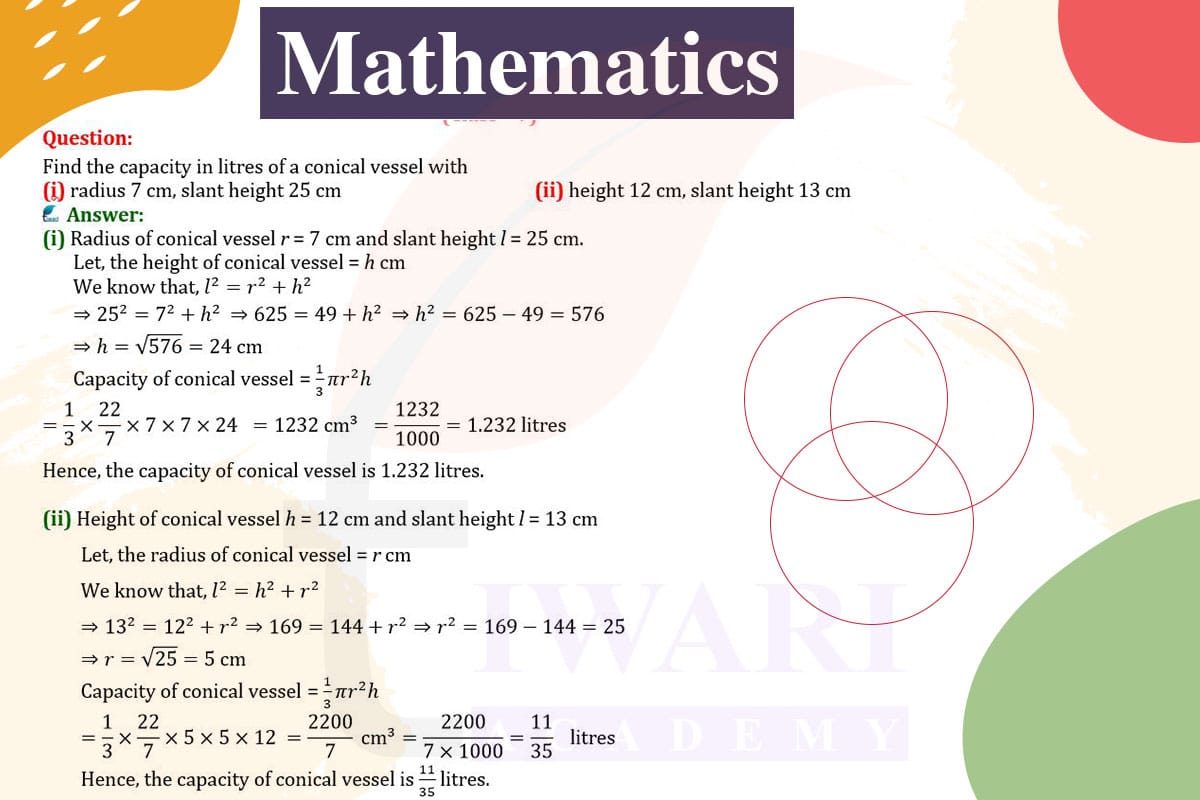Vessel with Radius 7 cm, Slant Height 25 cm:
First, find the height using Pythagoras’ theorem: h = √[l² − r²] = √[25² − 7²]. Then, calculate the volume: V = (1/3)πr²h. Convert this volume to liters.
Vessel with Height 12 cm, Slant Height 13 cm:
Find the radius: r = √[l² − h²] = √[13² − 12²]. Calculate the volume and convert to liters.
These steps yield the capacity of each conical vessel in liters.

Let’s discuss in detail
Conical Vessel Capacity Calculation
Calculating the capacity of a conical vessel is a practical application of geometry, particularly useful in various fields like engineering, manufacturing, and even in everyday scenarios like cooking or storage. A conical vessel, characterized by its circular base and a pointed top, can hold a certain amount of substance, typically liquid. The capacity of such a vessel is essentially its volume. To find this, one must understand the relationship between the dimensions of the cone (radius, height, and slant height) and its volume. This calculation becomes particularly interesting when only a subset of these dimensions is known, requiring the use of geometric principles to find the missing measurements.
Understanding the Geometry of a Cone
A right circular cone is defined by three main dimensions: the radius (r) of its circular base, its height (h), and the slant height (l). The slant height is the distance from the apex of the cone to any point on the edge of the base, forming a right triangle with the height and the radius. This relationship allows us to use Pythagoras’ theorem to find any missing dimension if two are known. The volume of the cone, which directly translates to its capacity, is calculated using the formula V = (1/3)πr²h, where V is the volume.
Calculating the Height from Slant Height and Radius
In cases where the slant height and radius are known, but the height is unknown, Pythagoras’ theorem comes into play. The theorem states that in a right-angled triangle, the square of the hypotenuse (slant height, in this case) is equal to the sum of the squares of the other two sides (height and radius). Therefore, the height can be calculated using the formula h = √[l² − r²]. This step is crucial for calculating the volume when the height is not directly provided.
Example Calculation with Radius and Slant Height
Consider a conical vessel with a radius of 7 cm and a slant height of 25 cm. First, calculate the height using h = √[25² − 7²]. Then, substitute this value into the volume formula to find the volume of the cone. After calculating the volume in cubic centimeters, convert it to liters by dividing by 1000, as 1 liter equals 1000 cubic centimeters. This process yields the capacity of the vessel in liters, demonstrating the practical application of geometric principles.
Example Calculation with Height and Slant Height
In another scenario, if a conical vessel has a height of 12 cm and a slant height of 13 cm, the radius can be found using Pythagoras’ theorem: r = √[13² − 12²]. With the radius at hand, the volume of the cone is calculated using the standard volume formula. This volume, once again, is converted to liters to find the capacity of the vessel. Such calculations are not only academically relevant but also have real-world applications in designing containers or vessels for specific purposes.
The Relevance of Cone Capacity Calculations
In conclusion, calculating the capacity of a conical vessel is a fundamental application of geometry, showcasing how mathematical concepts are used in practical, real-world situations. Whether it’s for designing a vessel for a specific purpose or for everyday use in the kitchen, understanding how to calculate the volume of a cone is invaluable. These calculations not only reinforce the importance of geometric principles but also highlight the interconnectedness of mathematics with everyday life.
Discuss this question in detail or visit to Class 9 Maths Chapter 11 for all questions.
Questions of 9th Maths Exercise 11.3 in Detail

